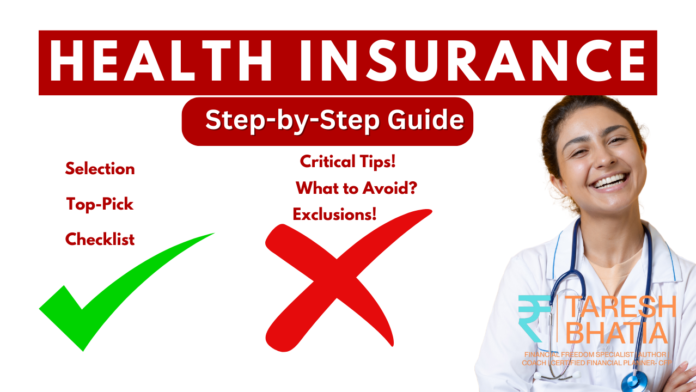As a CERTIFIED FINANCIAL PLANNER™ and founder of The Richness Academy, I often get this frustrated question from my clients:
“Taresh, why is my health insurance premium rising every year even when I haven’t claimed anything?”
A few months ago, a young entrepreneur couple from Gurugram, both in their early 30s, came to me shocked at their family floater renewal notice. Their premium had jumped by 22% in a single year. No hospitalization, no claims—still, the cost was rising.
So I took them through what I’m about to share with you in this blog—why health insurance premiums are rising across India, and more importantly, how you can beat the hike without sacrificing coverage.
⸻
Why Are Health Insurance Premiums Rising in India?

Let’s break this down, not just with facts, but with the reality behind the premiums:
1. Medical Inflation Is Real (10–15% Yearly Rise)
Costs of hospitalization, surgeries, medicines, and diagnostic tests are increasing faster than general inflation.
A basic knee replacement surgery that cost ₹2.5 lakh five years ago now crosses ₹4 lakh in many metro hospitals.
What this means: Your insurer needs to collect higher premiums to stay profitable.
⸻
2. Rise in Lifestyle-Driven Illnesses
More Indians are facing:
• Type 2 diabetes
• Hypertension
• PCOD and hormonal disorders
• Obesity-related complications
Even people in their 20s and 30s are visiting hospitals more frequently now than they did a decade ago.
Anecdote: A 29-year-old IT engineer I counselled had two hospitalizations in one year due to fatty liver and kidney stones—both linked to a sedentary lifestyle and erratic food habits.
⸻
3. Post-COVID Recalibration
COVID changed everything for insurers. Now even “mild” pre-existing conditions are looked at with more caution. Insurers restructured their underwriting and reserve margins, which affected premium pricing.
⸻
4. Increased Early Claims
Young policyholders who bought insurance for tax benefits are now filing small claims — for ₹20,000–₹50,000 hospitalizations. This increases claim ratios and affects premium pool stability.
⸻
5. Regulatory Changes (More Benefits, More Cost)
IRDAI mandates now include mental health coverage, modern treatments, and removal of exclusions. While this is great for us as policyholders, it increases the overall cost to insurers, which reflects in renewals.
⸻
How to Manage the Impact of Rising Premiums

Now let’s shift to the real solutions. I guide my clients through the following strategies so they stay protected without overpaying:
⸻
1. Buy Early – The Younger, The Cheaper
Your premium is primarily based on age and health status at entry. The earlier you start, the lower the base cost—and the more benefits you lock in.
Action: If you’re 30 today, buy long-term health cover now—even if you’re single or don’t feel the “need.” It’ll save you lakhs later.
⸻
2. Separate Parents’ Policies
Many people add their 60+ parents to their family floater plan, which massively inflates the premium.
Case Study: A couple in Mumbai saved ₹16,000 a year just by moving their 68-year-old father to a senior citizen-specific plan and keeping their own floater separately.
Action: Use standalone senior plans for parents. Add children or spouse only if they are under 50.
⸻
3. Use Super Top-Up Plans
Why pay ₹45,000 annually for a ₹20 lakh base cover when you can:
• Pay ₹10,000 for a ₹5 lakh base policy
• Add a super top-up of ₹15 lakh for ₹8,000–₹10,000
This combo gives the same protection at 40–50% lower premium.
Action: Ask your advisor to help you structure a top-up combo based on your hospital room preferences.
⸻
4. Opt for Higher Deductibles
Deductibles shift the initial small costs to you, and keep premiums low. If you’re healthy, you can afford a ₹50,000 deductible in exchange for long-term savings.
One of my clients, an airline pilot, saved ₹12,000 a year by opting for a ₹1 lakh deductible and covering small costs himself.
Action: If you don’t have frequent medical expenses, choose a deductible option that matches your savings.
⸻
5. Review and Compare Annually
Many people auto-renew for convenience, but that’s a missed opportunity.
Also read: How to Attract More Money and Achieve Financial Freedom with a Powerful Mindset
Action: Every year, compare:
• Waiting period policies
• Premium inflation
• Network hospitals
• Value-added services like teleconsultations
You can also port your policy if needed—IRDAI allows this.
⸻
What to Check When Buying Health Insurance

As a CERTIFIED FINANCIAL PLANNER™, this is the checklist I run through with every family or couple during a clarity session before they commit to a new health insurance policy.
Don’t just compare premiums—compare what matters most when you’re in the hospital, not just on paper.
Here’s what you must evaluate before choosing your plan:
⸻
1. Pre-Existing Disease (PED) Waiting Period
Look for plans that offer 1–2 years PED wait time (instead of the typical 3–4 years).
Early coverage equals early peace of mind.
⸻
2. Room Rent Limits
Go for “no cap” room eligibility or high cap tied to sum insured (e.g. 1% of ₹10L = ₹10,000/day).
Avoid low fixed caps like ₹3,000–₹5,000/day.
⸻
3. Daycare & Short-Stay Laser Surgeries
Choose plans that cover 500+ daycare procedures, especially laser and same-day surgeries like:
• Cataract
• Gall bladder stone removal
• Varicose veins
• Kidney stone procedures
Many insurers now support 2-hour hospitalization benefits.
⸻
4. Premium Lock-in for No Claims
Some policies freeze your premium for a block of 3–5 years unless you make a claim.
Ideal for healthy, young families.
Ask for “premium guarantee features” during proposal.
⸻
5. Restoration Benefit
When your base sum insured is exhausted mid-year, this feature recharges it automatically for future claims.
Great for joint family plans or senior parents.
⸻
6. Supercharged No-Claim Bonus (NCB Boosters)
Look for plans where:
• Your cover doubles each claim-free year
• Coverage grows up to 5x without additional premium
A ₹20L base cover can become ₹1 Cr in 5 years—without claim.
⸻
7. Claim Settlement Ratio & Speed
Choose insurers with:
• 95%+ claim settlement
• Seamless cashless approvals
• Transparent grievance handling
Always read customer reviews for real experiences.
⸻
8. Ambulance and Hospitalization Logistics
Check if your policy offers full reimbursement for:
• Road Ambulance – Covered up to sum insured
• Air Ambulance – Covered up to sum insured (great for Tier-2 cities)
• AYUSH Treatment – Covered for 24+ hrs in hospital (or 2+ hrs for regular hospitalization)
• Home Care/Domiciliary – Covered up to sum insured
If your city has traffic issues or if you travel often, air ambulance inclusion is critical.
⸻
9. Pre and Post-Hospitalization Expenses
Look for coverage of up to 60 days before and 180 days after hospital admission.
This includes:
• Pre-op tests
• Doctor consultations
• Medication
• Physiotherapy
Many claims are denied due to insufficient pre/post documentation. Choose plans with flexible and long-term windows.
⸻
10. Organ Donor Expenses
Full coverage up to sum insured for both organ harvesting and transplant surgery.
This is now a standard in quality health plans.
⸻
11. Annual Health Check-Up (Cashless Only)
Your plan should offer free annual health check-ups for all members—preferably cashless and network-based.
Helps track health trends and find early risks.
⸻
12. Maternity, IVF, Surrogacy & Adoption Support
Look for progressive policies that include:
• Maternity & newborn care
• IVF procedures
• Surrogacy assistance
• Adoption-related medical expenses
These are especially useful for younger couples planning a family or those exploring alternate parenthood routes.
⸻
13. Borderless/Global Treatment Cover
Some plans now offer international hospitalization cover with no geographical limits.
Each claim is topped up with the base sum insured and works seamlessly even abroad.
Ideal for couples who travel, NRIs, or those with overseas work opportunities.
⸻
14. Second Medical Opinion & E-Consultations
Choose plans with unlimited e-consults and second opinions within their provider network.
This is often a life-saving feature when surgery is recommended and you want reassurance.
⸻
Recommended Add-Ons I Suggest as a CFP™

These are optional but powerful add-ons that many of my clients benefit from:
1. Claim Safeguard+ – Covers all non-payable items like gloves, syringes, consumables (which often cause surprise deductions).
2. Hospital Daily Cash – Fixed payout during hospitalization:
• ₹1,000/day for base sum insured up to ₹5L
• ₹2,000/day for ₹7.5L–₹15L
• ₹4,000/day for policies above ₹15L
These cash benefits help cover out-of-pocket expenses or income loss during hospitalization.
⸻
Final Word
Buying a health insurance policy is no longer about “just having a cover.”
It’s about having the right cover—built for your lifestyle, family goals, city, age, and income.
Review your current plan today using this checklist.
If you’re confused or need clarity, I invite you to join my free live webinar for Indian couples or book a personal 1:1 session.
⸻
Join Free Webinar:
Taresh Bhatia, CFP®
Founder – The Richness Academy
Email: taresh@tareshbhatia.com
Website: www.tareshbhatia.com
The author of this article, Taresh Bhatia, is a Certified Financial Planner® and advocate for female empowerment. For more information and personalized financial guidance, please contact taresh@tareshbhatia.com
He has authored an Amazon best seller-“The Richness Principles”. He is the Coach and founder of The Richness Academy, an online coaching courses forum. This article serves educational purposes only and does not constitute financial advice. Consultation with a qualified financial professional is recommended before making any investment decisions. An educational purpose article only and not any advice whatsoever.
©️2025: All Rights Reserved. Taresh Bhatia. Certified Financial Planner®
Subscribe Now for Upcoming Blogs!
[convertkit form=6555951]
📢 Join free live webinar —
Couple Finance Formula™ Register here




